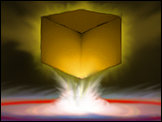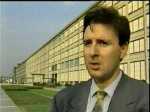|
|
| Defying the Laws of Gravity
Presented by: Graham Stevenson and Dylan Touhey SOURCE ARTICLE Achieving Anti-Gravity with Superconductor Electromagnetics In 1996, Russian émigré scientist Eugene Podkletnov (PhD in the manufacture of superconductors) submitted a peer-reviewed article to the respected British Journal of Physics-D. In this article Podkletnov claimed that he could prove a defiance of gravity. When a London newspaper published Podkletnov’s work, the skeptics tore him apart. Einstein had proved that you could not defy the laws of gravity! Subsequently, Podkletnov withdrew the article and was evicted by his university. In 1996 he retreated from the public eye and relocated to Finland.  While rotating a ceramic disc superconductor above powerful electromagnets, Podkletnov noticed something extremely strange. Small objects above the disc seemed to lose weight. It was as though they were being shielded from the gravitational pull of Earth. The weight reduction was small, measuring approximately 2% but this strange occurance had never been observed before. If the principles involved in the shielding process could be refined and intensified, the implications would be immense. Scientists theorize that practical and affordable gravity nullification could change our lives more radically than the invention of the internal combustion engine. One can imagine the convenience of a future in which vehicles can levitate freely. Does this idea seem far-fetched? It did to most physicists who laughed at Podkletnov's report. However, Riley Newman, a professor of physics at UC Irvine has researched gravity for 20 years and responded to the Podkletnov findings. "I think it's safe to say gravity shielding is not conceivable." Riley argued that perhaps Podkletnov had made a mistake, measuring magnetic fields or air currents instead of genuine weight reduction. When asked about providing proof, Podkletnov claimed that his results had been verified by researchers at two separate institutions. He refuses to identify these people for fear that they will be ridiculed and ruined by the gravity establishment. The gravity research team at NASA has made no secrets of their work, declassifying all information and cooperating in full with media and scientific anti-gravity enthusiasts. They have not produced any definite results, and so currently the only credentialed scientist claiming to have witnessed gravity modification is Podkletnov himself. When asked by reporters how this ideas were discovered Podkletnov announced that: Someone in the laboratory was smoking a pipe....and the pipe smoke rose in a column above the superconductor disc. So we placed a ball-shaped magnet above the disc, attached to a balance. The balance behaved strangely. We substituted a non-magnetic material, silicon, and still the balance was very strange. We found that any object above the disc lost some of its weight, and we found that if we rotated the disc, the effect was increased.When asked about Podkletnov’s experiment, John Cramer, a physicist who was familiar with the story stated, "I don't believe he has discovered a shield for gravity." Cramer insisted that huge amounts of energy would be required to achieve such an effect. Podkletnov claimed that "We do not need a lot of energy," he said. "We don't absorb the energy of the gravitational field. We may be controlling it, as a transistor controls the flow of electricity. No law of physics is broken. I am not one crazy guy in a lab; we had a team of six or seven, all good scientists." Few of Podkletnov's critics actually bothered to review his work. The majority of the scientific community couldn't believe such a major discovery in physics by such a no-status materials scientist fooling around at an obscure lab in Finland. It is true that Podkletnov wasn't a physicist; nevertheless, he did have a doctorate (in materials science) and he knew how to do careful lab work. When he wrote up his results, his papers were accepted for publication in a few physics journals. An Italian theoretical physicist named Giovanni Modanese became intrigued with Podkletnov’s findings. Modanese was not dismissive of the whole gravity shielding idea, reasoning that on a subatomic level scientists simply don't know exactly how gravity functions. "What we are lacking today," according to Modanese, "is a knowledge of the microscopic or 'quantum' aspects of gravity, comparable to the good microscopic knowledge we have of electromagnetic or nuclear forces. In this sense, the microscopic origin of the gravitational force is still unknown." Modanese developed a theory to explain the shielding phenomenon at the Max Planck Institute in Munich, Germany. In the United States, NASA’s scientists were thinking along similar lines as they obtained funding to replicate Podkletnov's experiment  How did Podkletnov accurately measure his claimed 2% weight reduction? Podkletnov used a mercury manometer which was placed above the disc. The manometer is similar to a barometer, and when placed above the superconductor, the disc recorded a 4-mm reduction in air pressure primarily to a reduction in the weight of the air. Podkletnov took his mercury manometer to a lab directly above the superconductor disk one story below. He foundexactly the same result as if his experiment was generating an invisible column of decreased gravityextending upward indefinitely into space. In 1990, before Podkletnov’s experiment, a scientist named Douglas Torr from the University of Alabama started publishing papers with a Chinese woman physicist named Ning Li. Together they predicted that superconductors could in fact affect the force of gravity. Podkletnov had accidentally validated their predictions. Torr and Li worked with the Marshall Spaceflight Center in Huntsville, where they eventually persuaded NASA to start a serious long-term investigation. Ning Li remained involved, while Douglas Torr relocated to South Carolina. In South Carolina Torr had ventured into even stranger territory. He released a document of antigravity news and space drive technology in an amateur E-Zine. The document described a "gravity generator" that would create a force beam in any desired direction. Torr’s research and development have been limited by funding. When asked about his publication at the Office of Technology Transfer at the University of South Carolina, Torr exclaimed to Wired Magazine that his document had been presented prematurely and that it had received wider distribution than was originally intended. Torr told reporters that his team was still working on the technology, and would prefer not to receive any publicity at the time. Bob Park is a physics professor at the University of Maryland and when asked about Podkletnov’s work he stated, "Well, we know that we can create shields for other fields, such as electromagnetic fields; so in that sense I suppose that a gravity shield does not violate any physical laws. Still, mostscientists would be reluctant to conclude anything publicly from this." (Park debunks "fringe" science in a weekly column for the American Physical Society's Web page) NASA’s Anti-Gravity Projects David Noever works for NASA as a theoretical physicist and is the key figure trying to replicate Podkletnov's work. Noever explained that the team is trying several different approaches to achieve such an effect. His team uses an assortment of 1-inch superconductor discs, made from every conceivable mix of ingredients. His project hardware is a beige-painted metal unit the size of a car battery and an insulated tank about a foot in diameter, with a large coil wrapped around the base capable of taking 800 amps. This tank contains a 6-inch disc rotating in liquid helium, with a gravimeter suspended above. Noever’s team is struggling to fabricate 12-inch discs. Current disks tend to fracture into pieces during pressing and a subsequent baking process during the 800 amp exercise. "This is what Podkletnov says is the heart of the matter," said Noever, "learning to make the discs. He said it could take us one or two years. He did reveal the composition." Noever implies that gravity may have properties of natural frequencies higher than those commonly used in X-rays or microwave machines. Such high frequencies penetrate all known materials. “A superconductor disc could resonate and downshift the frequency to a lower level where it could be blocked by normal matter....But this is all very speculative." Noever explained that this is but one of three theories that could explain gravity shielding. At NASA, David Noever theorizes that gravity reduction should diminish with distance. However, Podkletnov proved to his own satisfaction that the effect has no limit. If his 2% weight reduction is correct then a gravity shielding equipped vehicle could levitate with the uplifting force of the heavier air below. "I'm practically sure," Podkletnov says, "that within 10 years, this will be done.....If not by NASA, then by Russia." |
References:
|
| FAIR USE NOTICE: This page contains copyrighted material the use of which has not been specifically authorized by the copyright owner. Pegasus Research Consortium distributes this material without profit to those who have expressed a prior interest in receiving the included information for research and educational purposes. We believe this constitutes a fair use of any such copyrighted material as provided for in 17 U.S.C § 107. If you wish to use copyrighted material from this site for purposes of your own that go beyond fair use, you must obtain permission from the copyright owner. |
|
|